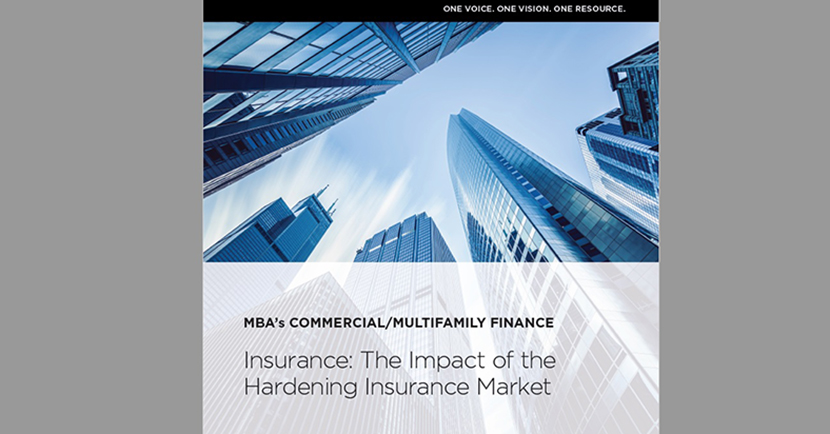
Insurance Quotes and Coverages: Hardening Insurance Market and Lender Implications

One of the many shifts occurring in the commercial real estate marketplace are evolving dynamics for insurance coverages and costs which help mitigate landlord and lender risks. These shifts impact existing borrowers and loans as well as new originations and all the different parties involved in the CRE finance ecosystem.
Whether one is focused on servicing, appraisal, originations or underwriting, expense shifts are significant inputs and drivers that impact stakeholders. MBA’s Servicer Council is made up of a series of committees and peer roundtables, some of which bring together insurance professionals who specialize in related areas and processes. Laura Smith is an active member in these committees and groups and a leading voice for MBA’s commercial/multifamily membership.
MBA Newslink interviewed Servicer Council Vice Chair Laura Smith and Nick Yuhas, who recently co-authored a white paper with other members of the Insurance Regulatory Group on the Hardening Insurance Market, available here.
Laura Smith is a Managing Director at Newmark, responsible for managing the Servicing Group for a $66 billion portfolio encompassing over 3,700 loans. She has over 27 years of experience in the lending, servicing and insurance industries with experience in many portfolio and property types. She is an active participant in many industry councils and maintains her Life, Accident & Health as well as her Property & Casualty insurance licenses.
Nick Yuhas is a Senior Vice President of Althans Insurance. Over the past twenty years he has specialized in developing and maintaining one of the most comprehensive Lender-Placed insurance programs for the commercial mortgage lending industry.
MBA NEWSLINK: MBA just released white paper on the hardening insurance market dynamics occurring. Can you tell us about the paper’s purpose and the group that helped to draft it?

LAURA SMITH: The MBA Insurance Regulatory Group is very excited to release our first white paper discussing the Hardening Insurance Market. There have been many changes within the past year in the insurance market that have impacted premiums, availability of coverage and coverage terms. Our team saw the need to examine these changes and be able to opine on the impact to the many stakeholders in the industry–investors, servicers, insurance agents/brokers, and borrowers to name a few.
The MBA Insurance Regulatory Group is a small group of experienced leaders within the various industries–investors, servicers, risk managers, insurance brokers/agents and insurance carriers. We meet regularly to discuss hot issues in the insurance market and the impact on the lending/servicing community.
NEWSLINK: What are some key takeaways in the white paper and who is the target audience?
SMITH: Some key takeaways from the white paper are that the insurance market has been hardening over the past year and will likely continue through the end of 2021 and likely in to 2022. Hardening is the limiting of availability of coverages, carriers that offer that coverage, and increasing premiums to help defray losses and market impacts.
During the new loan process, start your insurance review early in the new loan closing process because there will likely stumbling blocks and issues obtaining coverage’s and at a reasonable premium. From a servicing perspective, understand that the agents and brokers are likely binding the coverage last minute because they are trying to get the best premium and terms for the borrower and therefore, renewal evidences will be received close to or on the renewal date. The insurance compliance analyst reviewing the renewal information should ask the right questions to uncover deficiencies that may not be apparent in the ACORD form information provided by the insurance agent/broker.
Additionally, understand the impact insurance has on the deal as well as the loan after it closes. Partner with the investor to discuss the non-compliant coverage through the appropriate process (i.e. waiver, force placement, etc.) and be prepared to provide the relevant back up from the agent and the borrower surrounding the non-compliance as well as provide an opinion on the non-compliance and recommendation. It is important for the stakeholders to understand what is going on in the insurance marketplace and the challenges facing closing groups, insurance agents/brokers, carriers, lenders, as well as insurance compliance staff within the servicing shops.
As for the target audience, I think this paper is for a very broad audience including originators, closing staff, underwriters, lenders, insurance brokers/agents, and servicing personnel. It is meant to be general and easy to understand for all audiences, even those with no insurance background.
NEWSLINK: Nick, you work on these issues not as a servicer with a compliance focus but in a brokerage role. How do these market dynamics impact your role?

NICK YUHAS: Very challenging to say the least. Especially if the asset/insured is in a catastrophic prone area. SUCH perils as wind & hail, earthquake, flood, terrorism, and wildfires are certainly becoming tougher and more costly placements for property coverage. Prior loss history, loss control visits that may identify areas of concerns need to be addressed as well. Roofs are being limited for cosmetic loss as well as acv for age by insurance company.
NEWSLINK: What is some advice you give borrowers or lenders as they seek to manage risks in this type of market environment?
YUHAS: Start your renewals early–at least 120 days before the renewal, attempt to negotiate multi-year deals if the insurers are willing to commit. You can attempt to tie this multi-year deal to a specific loss ratio if the insurance company is hesitant. If acquiring new assets, be sure to review prior insurance policies for cost and loss history to estimate what new pricing may look like. Lastly, if there are any recommendation or requirements from past loss control visits then a cost analysis should be conducted to determine if there is a substantial return on investment.
(Views expressed in this article do not necessarily reflect policy of the Mortgage Bankers Association, nor do they connote an MBA endorsement of a specific company, product or service. MBA NewsLink welcomes your submissions. Inquiries can be sent to Mike Sorohan, editor, at msorohan@mba.org; or Michael Tucker, editorial manager, at mtucker@mba.org.)
